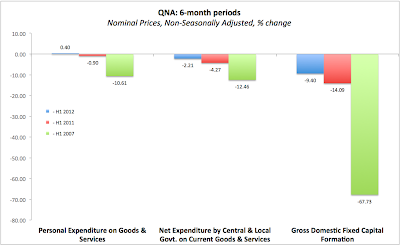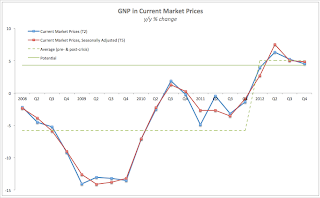This is an unedited version of my
Sunday Times article from August 11, 2013.
Recent data from Irish retailers, aggregate services indices as well as household surveys paints a picture of an economy divided in misery and fortunes. Following an already unprecedented five years of straight declines, domestic demand, stripping out one-off effects, such as weather, continues to shrink. This is the paralysed core of our economy. At the opposite side of the spectrum, pockets of strength remain within some demographic groups – namely the young and mobile professionals and debt-free older households. These form a de facto sub-economy only marginally attached to Ireland’s long-term future. With personal consumption still accounting for over half of the total annual GDP, a society torn between these two divergent drivers of domestic demand, savings and investment, is an economy at risk.
On the surface, CSO data through H1 2013 shows that Irish retail sales (excluding cars) grew modestly in June 2013 when compared to the same period a year ago. Much of this growth was due to weather effects and these are likely to strengthen even further in the third quarter. However, removing food, fuel and bars sales, core retail sales were down 1.7 percent in value and were up 0.8% percent in volume in April-June 2013, year-on-year. In other words, core sales are still being driven primarily by price declines rather than by organic growth in demand.
Meanwhile, aggregate data released this week, covering services (as opposed to sales of goods alone) showed annual declines in June 2013 in accommodation, and food and beverage services activities.
The bad news is that five years into the process of reducing household expenditures, Irish consumers are still tightening their belts. Not only discretionary spending is dropping, but demand for staples is contracting as well. At the end of H1 2013, retail sales were down on 2007 levels for both durable and non-durable household consumption items, as well as food.
This data is largely consistent with the analysis of the household budget surveys released earlier this month. These surveys showed that compared to 2009, Irish households have cut deeper into their bills in twelve months through Q3 2012. Demand for groceries, clothing and footware, recreation, health Insurance and education saw continued cutbacks. For example, in the 24 months prior to June 2011, 56 percent of Irish households cut down on food purchases. Further 51 percent cut spending in the 12 months through September 2012. Despite these already severe cutbacks, industry surveys show that Irish households are still concerned with high cost of basic consumables.
Households’ propensity to cut costs has risen in the twelve months through September 2012 compared to the 24 months period to June 2011 as those still holding onto their jobs are now shifting into deeper cost savings mode. This busts the myth that the only people forced to severely cut their spending are the unemployed and the poor. The largest proportion of severe cuts in the earlier part of the recession fell onto the shoulders of the households where at least one person was jobless, followed by students. Back then households in employment were the category second least impacted by household budgets cuts. Last year, households still in employment were the second most likely to reduce spending. Significantly - households with some members on home duties, retired or not at work due to illness or disability posted the shallowest average cuts of all demographic groups.
The above explains why the data from multiples retailers in Ireland has been showing a V-shaped pattern of changes in consumer demand, with higher demand witnessed in lower-priced categories of own-brand goods supplied by discount retailers, such as Aldi and Lidl, and the premium own-brands of traditional multiples, such as Tesco. Demand for mid-range priced goods usually purchased by the middle class continued to fall.
Ditto for the luxury end of the market, with exception of Dublin, as sales of food and drink in specialist stores have fallen almost 20 percent on pre-crisis peak. Exactly the same pattern of shift away from the middle of price range sales emerged in the demand for electrical goods.
The drivers for the above trends are crystal clear. Middle Ireland is under severe pressures financially, while Happily-Retired and Yappy Irelands are having a relatively easy recession or living through the good times. The main force working through the Irish domestic demand is that of polarization of households not along the lines of employed v unemployed, but along the more complex and fragmented demographic lines.
The average number of spending cutbacks in 12 months through September 2012 for households with no person at work stood at 2.6 categories of spending. The same numbers for households with one and two persons working were 3.3 and 3.2 categories, respectively.
This pattern of cutbacks and income distribution changes across the households is also strengthening over time. In effect, due to Government policies, Ireland is becoming a country with severely polarised distribution of financial well-being. This polarisation is contrary to the one witnessed in normal economies and is different from the one that majority of out policymakers and analysts have been decrying to-date.
The Great Recession has finally exhausted ordinary savings of both working and unemployed households, while lack of income growth has meant that even those in employment are now sinking under the weight of debt and tax and cost inflation driven by the State budgetary policies to-date.
Last week, CSO reported distribution of the households by their ability to manage bills and debts over 12 months prior to July-September 2012. Of households with at least one adult aged 65 and over, up to 28 percent were experiencing difficulties in managing their debts and bills. For households with all adults under the age of 65 the corresponding number was up to 46 percent. Up to 69 percent of the families with children were in the same boat. The older the respondent was, the less pressure on paying their bills their reported.
In normal economies it is the older families that face tighter budget constraints. In today's Ireland it is the younger and the middle-age families with children that are being pressured the hardest by the crisis. This bedrock of financial health in the normal times has been pulled from underneath the economy by the Great Recession.
At the same time, the crisis has generated a new class of the relatively well-off. Based on employment levels and quality, earnings, as well as regular and irregular bonuses data, three sectors in the Irish economy stand out as the winners during the crisis: the ICT services, specialist exports-focused services and international financial services. All three sectors are dominated by younger workers with high percentage of employees coming from abroad and working on a temporary assignment basis here. The demographic they represent is primarily from mid-20s through mid-30s, with smaller size families. These groups of employees are also heavily concentrated geographically, with exporting services sectors workers primarily living in Dublin, followed by a handful of other core urban areas.
Even as early as 2006-2007, market research has shown that these types of households favour premium consumption of convenience food, spend more of their income on going out and travel abroad, and less on purchases of durable goods, household goods, education and health insurance. They do not invest in this economy and hold off-shore most of their long-term savings. Their financial investments are also held and managed abroad and often include mostly shares and options in their own employers. Their children are not going to continue growing up in Ireland and will not be a part of our future workforce. The skills they accumulate while working here are transitory to the overall stock of Irish human capital. On a social level, their demand for entertainment is currently best exemplified by the booming restaurants and bars across the D2-D4-D6 areas of Dublin and stands in stark contrast to Middle Ireland’s hollowed out town centres and neighborhoods with empty storefronts and vacant building sites.
Today’s Ireland is a society where the middle class and large swaths of the upper-middle class have been dragged under water by the combination of the unprecedented crisis, compounded by rampant state-sanctioned cost inflation and legacy debt.
The data on domestic demand suggests that we might be entering a classic ‘Bull trap’. Here, tight rental markets in the leafy South Dublin neighborhoods fuels sales of rentable properties to service the needs of the Yappy Ireland. These pockets of activity are at a risk of generating inflated expectations of incoming prosperity. Don’t be fooled by this – the risks to the real Irish economy are still there, in plain view, in the streets of real Ireland.
Recognising this reality requires the Government to reconsider the tax increases that are impacting adversely the middle and the upper-middle classes. It also means that the State must reform, rapidly and thoroughly the semi-state sector to reduce the cost drag exerted by the Irish utilities, transportation, health and education services providers on Middle Ireland families’ balancesheets. Lastly, prudent risk management requires for us to manage very carefully the process of mortgages arrears restructuring and debt work-outs. While many economy have survived sovereign and banking sectors busts, no economy can emerge from a crisis having destroyed its middle classes.
Box-out:
In Ptolemaic cosmology, astronomers believed that the Earth was the centre of the Universe. To balance this Universe, Ptolemists used to draw complex sets of larger and smaller circles - known as epicycles - to describes their orbits around the Earth. The problem with epicycles spelled the demise of the Ptolemaic cosmology in the end: as the known number of planets and stars increased, the system of superficial orbits rapidly collapsed under its own complexity. The Ptolemaic absurdity, however, is still alive today in Irish economic policies. A year ago, the Government had a clear choice of policy options: a site-value tax (SVT) that can be levied on all forms of properties, including land, or a residential property tax that can be levied only on structures. In a study covering all known forms of policy mechanisms used to fund public infrastructure around the world, submitted to the Department of Environment, I have argued that one of the major advantage of the SVT over a property tax was that it would have incentivised more efficient use land, reducing land hoarding and speculation. There were multiple other advantages of SVT over the property tax as well. Alas, the Government opted for a property tax favouring under-use of land over all other properties. This tax suits the major lobbies influencing the State: farmers and well-off rural landed families. Fast-forward eight months from last December: this week, Dublin City Council called for a levy on unused vacant sites. Hundreds of sites lay vacant across the city - blotching the cityscape and posing a threat to personal safety to many workers, as well as an unpleasant reminder of the property bust and economy's dysfunctionality to the would-be foreign investors. Dublin City has been trying to force this land back into development since 2009, although no one in the city has a slightest idea where the demand for such development might come from. Thus, our Ptolemaic system of economic policies is about to draw yet another contrived, complex and inefficient balancing circle on the map of our tax policies to compensate for the Government's rejection of the site value tax. After all, managing the superficial complexity of a political economy that attempts to appease the landed classes, while satisfying the needs and demands of foreign investors and urban authorities is an arduous task



















































